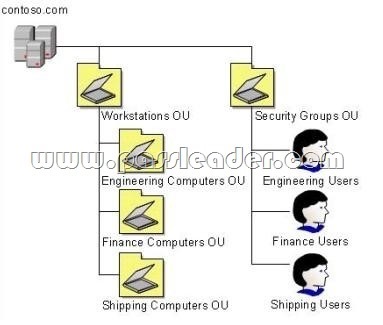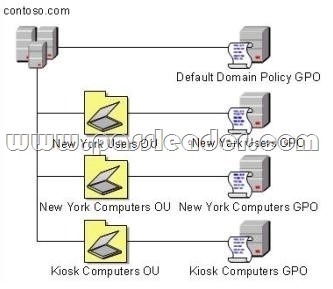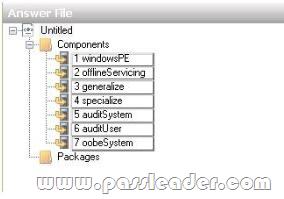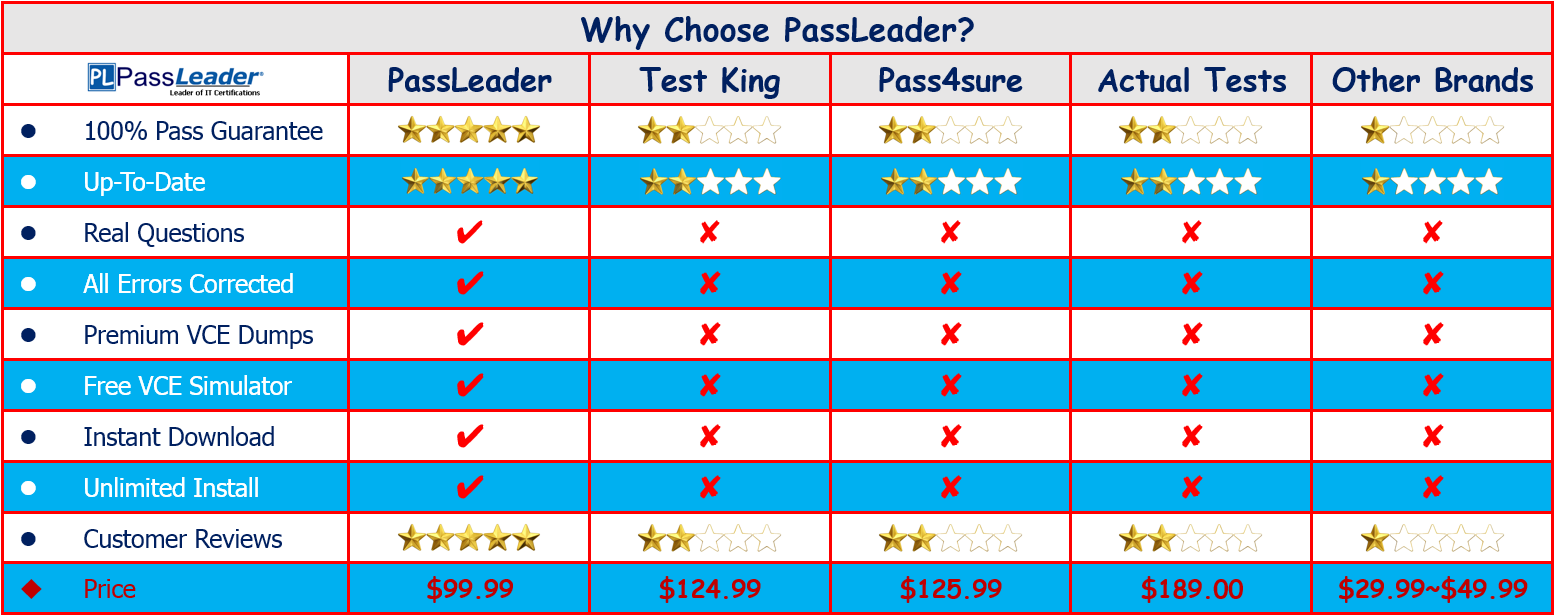QUESTION 21
Your network has client computers that run Windows Vista. You are planning to deploy Windows 7. You need to detect and analyze the compatibility of an application that requires elevated privileges. What should you do?
A. Use the Standard User Analyzer (SUA) Wizard.
B. Run a virtual version of the Setup Analysis Tool (SAT).
C. Use the Standard User Analyzer (SUA) tool.
D. Run a stand-alone version of the Setup Analysis Tool (SAT).
Answer: C
QUESTION 22
Your company’s network has client computers that run Windows 7. Multiple users share the computers in the shipping department. These computers reside in the Shipping Computers organizational unit (OU). The company wants to deploy a new application. The application is not packaged. You have the following requirements:
— Deploy the application to all computers in the shipping department.
— Perform the deployment from a central location.
You need to plan the software deployment process to meet the requirements. Which two actions should you include in the process? (Each correct answer presents part of the solution. Choose two.)
A. Using Microsoft System Center Configuration Manager, create a collection that contains the shipping department computers, and assign the package to the collection.
B. Create a package by using Microsoft System Center Configuration Manager.
C. Create a Group Policy object (GPO) and add a software installation policy under the Computer Configuration container.
D. In the Group Policy Management Console, link the software installation policy to the Shipping Computers OU.
E. Using Microsoft System Center Configuration Manager, create a collection that contains the shipping department users, and assign the package to the collection.
Answer: AB
QUESTION 23
Your network has client computers that run Windows XP. All users access a custom line-ofbusiness application. The line-of-business application is not compatible with Windows 7. You are planning to deploy Windows 7. You have the following requirements:
— The application must run on all client computers.
— The application executable must reside on each client computer.
You need to manage application compatibility to meet the requirements. What should you do?
A. Install the application on a Remote Desktop Services server.
B. Install a shim for the application on each client computer.
C. Virtualize the application by using Microsoft Application Virtualization (App-V).
D. Install the Windows Compatibility Evaluator on each client computer.
Answer: B
QUESTION 24
Your company has 1,000 client computers that run Windows XP Professional x64. You are planning to deploy Windows 7 Enterprise x64. The company uses an application that is incompatible with Windows 7 Enterprise x64. You have the following requirements:
— Provide all users with access to the application.
— Deploy and manage the application by using a centralized solution.
You need to design a solution that meets the requirements. What should you do?
A. Install the application on all client computers by using Group Policy, and then use the Compatibility tab.
B. Install the Microsoft Application Virtualization (App-V) client on each client computer, and run the application in offline mode.
C. Install the Microsoft Enterprise Desktop Virtualization (MED-V) package on each client computer.
D. Install the Microsoft Application Virtualization (App-V) client on each client computer, and stream the application by using App-V.
Answer: C
QUESTION 25
Your companys network has client computers that run Windows 7. Multiple users share the computers in the shipping department. These computers reside in the Shipping Computers organizational unit (OU). The network design is shown in the following diagram. 
You are planning to deploy an application. The application is packaged as a Microsoft Windows Installer package (MSI). You need to deploy the application only to computers in the shipping department. Which two actions should you perform? (Each correct answer presents part of the solution. Choose two.)
A. Link the software installation policy to the Workstations OU.
B. Link the software installation policy to the Shipping Computers OU.
C. Create a new Group Policy object (GPO) and add a software installation policy under the User Configuration container.
D. Create a new Group Policy object (GPO) and add a software installation policy under the Computer Configuration container.
Answer: BD
QUESTION 26
Your company has 1,000 Windows XP computers. You plan to migrate these computers to Windows 7. You need to detect compatibility issues that can occur during the installation and configuration process for a specific application. Which tool should you use?
A. Windows Compatibility Evaluator
B. Setup Analysis Tool
C. Inventory Collector
D. Update Compatibility Evaluator
Answer: B
QUESTION 27
Your companys network has client computers that run Windows 7. When a user attempts to log on to the domain from a computer named Client1, she receives the following message: The system cannot log you on to this domain because the system’s computer account in its primary domain is missing or the password on that account is incorrect. You need to ensure that the user can log on to the domain from Client1. What should you do?
A. Disjoin and rejoin Client1 to the domain.
B. Reset the account password for Client1 through Active Directory Users and Computers.
C. Add the computer account for Client1 to the Domain Computers Active Directory group.
D. Reset the account password for the user through Active Directory Users and Computers.
Answer: A
QUESTION 28
Your company has two Active Directory Domain Services (AD DS) domains, Domain1 and Domain2. A two-way trust relationship exists between the domains. Users in both domains can log on to client computers in only their own domains. System logs on the domain controllers display the error message Clock skew too great when users in Domain1 attempt to log on to client computers in Domain2. You need to ensure that users can log on to client computers in both domains. What should you do?
A. Decrease the Maximum tolerance for computer clock synchronization setting in the default Domain Group Policy object ( GPO ).
B. Configure the primary domain controller (PDC) emulatorin each domain to synchronize its clock with the same external time source.
C. Run a startup script that includes Net Time /setsntp on all client computers.
D. Run a startup script that includes Net Time /querysntp on all client computers.
Answer: B
QUESTION 29
Your company has an Active Directory Domain Services (AD DS) forest with a single domain named contoso.com. The design of the organizational units (OUs) and Group Policy objects (GPOs) is shown in the following diagram. 
Multiple computer configuration settings and user configuration settings are defined in the Kiosk Computers GPO. A security audit indicates that user configuration settings that are defined in the Kiosk Computers GPO are not applied when users log on to client computers that are in the Kiosk Computers OU. You need to ensure that the user configuration settings are correctly applied. What should you do?
A. Enable loopback processing in Merge mode on the Default Domain Policy GPO.
B. Disable the user configuration settings on the Default Domain Policy GPO.
C. Enable loopback processing in Replace mode on the Kiosk Computers GPO.
D. Disable the user configuration settings on the New York Users GPO.
Answer: C
QUESTION 30
You have a single Active Directory Domain Services (AD DS) site. All client computers run Windows 7. Users in the marketing department use a custom application. You create a new Group Policy object (GPO) and link it to the site. Users in the marketing department then report that they are unable to use the custom application. You need to ensure that all users in the marketing department are able to use the custom application. You need to ensure that all other users continue to receive the new GPO. What should you do?
A. Add marketing users to a domain group. Use security filtering to grant the group the Allow-Read permission and the Allow-Apply Group Policy permission for the GPO.
B. Move marketing users to a dedicated organizational unit (OU). Apply the Block Inheritance setting to the OU.
C. Add marketing users to a domain group. Use security filtering to grant the group the Allow-Read permission and the Deny-Apply Group Policy permission for the GPO.
D. Move marketing users to a dedicated organizational unit (OU). Apply the Block Inheritance setting to the domain.
Answer: C
http://www.passleader.com/70-686.html
QUESTION 31
You use Group Policy to standardize Internet Explorer settings on Windows 7 client computers. Users occasionally change the Internet Explorer settings on individual client computers. The company wants to maintain a standard Internet Explorer configuration on all client computers. You need to ensure that the standard Internet Explorer configuration is in place each time users log on to client computers. What should you do?
A. Use Group Policy to disable the Advanced tab of the Internet Explorer Properties dialog box.
B. Use the Group Policy Update utility to refresh Group Policy.
C. Enable Internet Explorer Maintenance Policy Processing in Group Policy.
D. Enable User Group Policy loopback processing mode.
Answer: C
QUESTION 32
Your companys network includes client computers that run Windows 7. You design a wireless network to use Extensible Authentication ProtocolCTransport Level Security (EAP-TLS). The Network Policy Server has a certificate installed. Client computers are unable to connect to the wireless access points. You need to enable client computers to connect to the wireless network. What should you do?
A. Install a certificate in the Trusted Root Certification Authorities certificate store.
B. Configure client computers to use Protected Extensible Authentication ProtocolCTransport Layer Security (PEAP-TLS).
C. Configure client computers to use Protected Extensible Authentication Protocol-Microsoft Challenge Handshake Authentication Protocol version 2 (PEAP-MS-CHAP v2).
D. Install a certificate in the Third-Party Root Certification Authorities certificate store.
Answer: A
QUESTION 33
Your company infrastructure includes a Windows Server 2008 R2 file server and 1,000 Windows 7 Enterprise client computers. The company wants to require a secure connection between client computers and the file server. You need to create and deploy a Group Policy object (GPO) that includes a rule for Windows Firewall with Advanced Security. What should you do?
A. Create an Isolation rule and specify Request authentication for inbound and outbound connections.
B. Create a Tunnel rule and specify Gateway-to-client as the tunnel type.
C. Create a Server-to-server rule and specify the endpoints as Any IP address and the file server IP address.
D. Create an Authentication exemption rule and add the file server IP address to the Exempt Computers list.
Answer: C
QUESTION 34
You deploy Windows 7 to the computers that are used by your companys Web developers. All Web developer user accounts are in a single organizational unit (OU). Internet Explorer is blocking pop-up windows for multiple internal Web applications that are hosted on different servers. You need to use Group Policy to ensure that Internet Explorer does not block pop-up windows for internal Web applications. What should you do?
A. Enable Compatibility View in Internet Explorer.
B. Add each server to the Intranet zone.
C. Add each server to the Trusted Sites zone.
D. Set the default security setting in Internet Explorer to Medium.
Answer: B
QUESTION 35
Your network has client computers that run Windows 7 Enterprise. You plan to deploy new administrative template policy settings by using custom ADMX files. You create the custom ADMX files, and you save them on a network share. You start Group Policy Object Editor (GPO Editor). The custom ADMX files are not available in the Group Policy editing session. You need to ensure that the ADMX files are available to the GPO Editor. What should you do?
A. Copy the ADMX files to the % systemroot% \ inf folder on each Windows 7 computer, and then restart the GPO Editor.
B. Set the network share permissions to grant all Windows 7 users Read access for the share.
C. Copy the ADMX files to the %systemroot% \ system32 folder on each Windows 7 computer, and then restart the GPO Editor.
D. Copy the ADMX files to the central store, and then restart the GPO Editor.
Answer: D
QUESTION 36
You are planning to deploy Windows 7 Enterprise to all of your company’s client computers. You have the following requirements:
— Create two custom partitions on each client computers hard disk, one for the operating system and the other for data.
— Automatically create the partitions during Windows Setup.
You need to design an image that meets the requirements. What should you do?
A. Use SysPrep to create the two partitions during Windows Setup.
B. Use Windows PE to create the partitions. Install Windows 7 on the first partition.
C. Use Windows System Image Manager (Windows SIM) to specify the partition configuration.
D. Use Disk Management to create the two partitions on the hard disk.
Answer: C
QUESTION 37
You plan to deploy an image of Windows 7 Enterprise to 1,000 client computers. You need to design a custom image that will enable users to connect to a Telnet server. What should you do?
A. Create a Network Connection before capturing the image.
B. Turn on the Telnet Server feature in the image.
C. Create a Certificate-Based credential before capturing the image.
D. Turn on the Telnet Client feature in the image.
Answer: D
QUESTION 38
You are designing a Windows 7 deployment image. You plan to install Windows 7 Enterprise with a Multiple Activation Key (MAK). You need to add the MAK to the configuration pass by using an answer file. To which configuration pass should you add the MAK? 
QUESTION 39
You are planning a migration to Windows 7. You need to recommend applications that obtain a list of software installed on client computers. Which applications should you recommend? (Choose all that apply.)
A. Microsoft Deployment Toolkit (MDT)
B. Sysprep
C. Microsoft Assessment and Planning Toolkit (MAP)
D. Microsoft Application Compatibility Toolkit (ACT)
E. windows User State Migration Tool (USMT)
F. Windows System Image Manager (windows SIM)
Answer: CD
QUESTION 40
You are designing a Windows 7 deployment image. You receive a baseline image over the network, from a different geographic location. You need to verify that the baseline image is valid. Which tool should you use?
A. ImageX
B. the Deployment Image Servicing and Management (DISM) tool
C. Windows Compatibility Evaluator
D. windows System Image Manager (Windows SIM)
Answer: A
Pass 70-686 Test With Passleader 70-686 Certification Dumps In First Attempt
http://www.passleader.com/70-686.html

![PassLeader[1] PassLeader[1]](http://examgod.com/plimages/2b1d2a159ca6_AC1C/PassLeader1.png)
